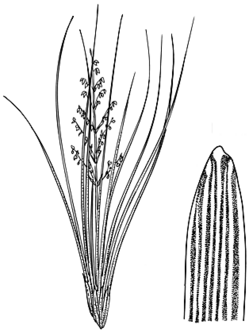Lomandra laxa (R.Br.) A.T.Lee APNI* Synonyms: Xerotes laxa R.Br. APNI*

Description: Perennial tussock, sparse; stems short with leaves c. 40 cm long, or stems extended and decumbent with leaves c. 20 cm long.
Leaves flat, rather thin, 2–4 mm wide, bluish grey when dry; apex rounded-acute or rounded-truncate; sheath margins intact, whitish, or slightly lacerated in age and brownish.
Inflorescence often nearly as long as leaves with well-spaced, separate flowers on fine axes; scape half to as long as rachis. Male inflorescence with opposite or whorled branches. Female inflorescence similar, less well-developed. Bracts ovate, 1–2 mm long; inner bract sometimes absent. Flowers creamish white. Male flowers c. 2–2.5 mm long; pedicel spreading to recurved, c. 2 mm long. Female flowers 4–6 mm long; pedicel 0.5 mm long. Outer tepals broad-elliptic to ± circular, shorter and more membranous than the thick inner tepals.
Flowering: mostly autumn–winter.
Distribution and occurrence: Commonly grows in marginal rainforest habitats, also in sandy soils over sandstone and in deep sands; north from Bulahdelah.
NSW subdivisions: NC
Other Australian states: Qld
The autumn to winter flowering, together with regularly whorled and very fine inflorescence axes, thin flat leaves, usually thinner texture of the tepals and short pedicels are features that distinguish L. laxa, especially from some of the large northern forms of L. filiformis.
Text by A. L. Quirico
Taxon concept: Flora of NSW 4 (1993)
APNI* Provides a link to the Australian Plant Name Index (hosted by the Australian National Botanic Gardens) for comprehensive bibliographic data
***The AVH map option provides a detailed interactive Australia wide distribution map drawn from collections held by all major Australian herbaria participating in the Australian Virtual Herbarium project.
|


